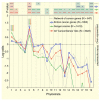Cellular hyperproliferation and cancer as evolutionary variables
- PMID: 22975008
- PMCID: PMC3590310
- DOI: 10.1016/j.cub.2012.08.008
Cellular hyperproliferation and cancer as evolutionary variables
Abstract
Technological advances in biology have begun to dramatically change the way we think about evolution, development, health and disease. The ability to sequence the genomes of many individuals within a population, and across multiple species, has opened the door to the possibility of answering some long-standing and perplexing questions about our own genetic heritage. One such question revolves around the nature of cellular hyperproliferation. This cellular behavior is used to effect wound healing in most animals, as well as, in some animals, the regeneration of lost body parts. Yet at the same time, cellular hyperproliferation is the fundamental pathological condition responsible for cancers in humans. Here, I will discuss why microevolution, macroevolution and developmental biology all have to be taken into consideration when interpreting studies of both normal and malignant hyperproliferation. I will also illustrate how a synthesis of evolutionary sciences and developmental biology through the study of diverse model organisms can inform our understanding of both health and disease.
Copyright © 2012 Elsevier Ltd. All rights reserved.
Figures




Similar articles
-
[Regeneration of planarians: experimental object].Ontogenez. 2015 Jan-Feb;46(1):3-12. Ontogenez. 2015. PMID: 25898529 Review. Russian.
-
[Molecular approach to planarian stem cell system].Tanpakushitsu Kakusan Koso. 2005 May;50(6 Suppl):706-10. Tanpakushitsu Kakusan Koso. 2005. PMID: 15926503 Review. Japanese. No abstract available.
-
The PIWI proteins SMEDWI-2 and SMEDWI-3 are required for stem cell function and piRNA expression in planarians.RNA. 2008 Jun;14(6):1174-86. doi: 10.1261/rna.1085008. Epub 2008 May 2. RNA. 2008. PMID: 18456843 Free PMC article.
-
A planarian p53 homolog regulates proliferation and self-renewal in adult stem cell lineages.Development. 2010 Jan;137(2):213-21. doi: 10.1242/dev.044297. Development. 2010. PMID: 20040488 Free PMC article.
-
Djmek is involved in planarian regeneration by regulation of cell proliferation and apoptosis.Biochem Biophys Res Commun. 2020 Nov 12;532(3):355-361. doi: 10.1016/j.bbrc.2020.08.027. Epub 2020 Sep 2. Biochem Biophys Res Commun. 2020. PMID: 32888646
Cited by
-
The Elephant and the Spandrel.Evol Med Public Health. 2024 Aug 26;13(1):92-100. doi: 10.1093/emph/eoae019. eCollection 2025. Evol Med Public Health. 2024. PMID: 40276264 Free PMC article.
-
Echinobase: a resource to support the echinoderm research community.Genetics. 2024 May 7;227(1):iyae002. doi: 10.1093/genetics/iyae002. Genetics. 2024. PMID: 38262680 Free PMC article.
-
Cancer progression as a sequence of atavistic reversions.Bioessays. 2021 Jul;43(7):e2000305. doi: 10.1002/bies.202000305. Epub 2021 May 13. Bioessays. 2021. PMID: 33984158 Free PMC article.
-
Ancient genes establish stress-induced mutation as a hallmark of cancer.PLoS One. 2017 Apr 25;12(4):e0176258. doi: 10.1371/journal.pone.0176258. eCollection 2017. PLoS One. 2017. PMID: 28441401 Free PMC article.
-
Evolutionary determinants of cancer.Cancer Discov. 2015 Aug;5(8):806-20. doi: 10.1158/2159-8290.CD-15-0439. Epub 2015 Jul 20. Cancer Discov. 2015. PMID: 26193902 Free PMC article. Review.
References
-
- Howlader N, N. A, Krapcho M, Neyman N, Aminou R, Waldron W, Altekruse SF, Kosary CL, Ruhl J, Tatalovich Z, Cho H, Mariotto A, Eisner MP, Lewis DR, Chen HS, Feuer EJ, Cronin KA, Edwards BK, editors. SEER Cancer Statistics Review, 1975-2008. National Cancer Institute; Bethesda, MD: 2011.
- Based on November 2010 SEER data submission, posted to the SEER web site. National Institutes of Health, National Cancer Institute; 2011. Volume Based on November 2010 SEER data submission, posted to the SEER web site. 2011.
-
- Pearson BJ, Sánchez Alvarado A. Regeneration, stem cells, and the evolution of tumor suppression. Cold Spring Harb. Symp. Quant. Biol. 2008;73:565–572. - PubMed
Publication types
MeSH terms
Substances
Grants and funding
LinkOut - more resources
Full Text Sources

